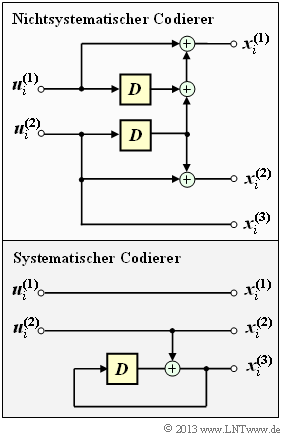Difference between revisions of "Aufgaben:Exercise 3.4Z: Equivalent Convolution Codes?"
| Line 118: | Line 118: | ||
1+D & 0 \\ | 1+D & 0 \\ | ||
D & 1+D | D & 1+D | ||
| − | \end{pmatrix} =\\ | + | \end{pmatrix} =$$ |
| − | + | :$$ \ = \ \hspace{-0.15cm} ... \hspace{0.1cm}= \frac{1}{1+D^2} \cdot | |
\begin{pmatrix} | \begin{pmatrix} | ||
1+D^2 & 0 \\ | 1+D^2 & 0 \\ | ||
Revision as of 11:07, 30 November 2017
Die obere Darstellung zeigt einen Faltungscodierer, der durch folgende Gleichungen beschrieben wird:
- $$x_i^{(1)} \hspace{-0.15cm} \ = \ \hspace{-0.15cm} u_{i}^{(1)} + u_{i-1}^{(1)}+ u_{i-1}^{(2)} \hspace{0.05cm},$$
- $$x_i^{(2)} \hspace{-0.15cm} \ = \ \hspace{-0.15cm} u_{i}^{(2)} + u_{i-1}^{(2)} \hspace{0.05cm},$$
- $$x_i^{(3)} \hspace{-0.15cm} \ = \ \hspace{-0.15cm} u_{i}^{(2)}\hspace{0.05cm}.$$
Gesucht sind die Übertragungsfunktionsmatrizen
- $\mathbf{G}(D)$ dieses nichtsystematischen Codes, und
- $\mathbf{G}_{\rm sys}(D)$ des äquivalenten systematischen Codes.
Die Matrix $\mathbf{G}_{\rm sys}(D)$ erhält man in folgender Weise:
- Man spaltet von der $k × n$–Matrix $\mathbf{G}(D)$ vorne eine quadratische Matrix $\mathbf{T}(D)$ mit jeweils $k$ Zahlen und Spalten ab. Den Rest bezeichnet man mit $\mathbf{Q}(D)$.
- Anschließend berechnet man die zu $\mathbf{T}(D)$ inverse Matrix $\mathbf{T}^{–1}(D)$ und daraus die gesuchte Matrix für den äquivalenten systematischen Code:
- $${\boldsymbol{\rm G}}_{\rm sys}(D)= {\boldsymbol{\rm T}}^{-1}(D) \cdot {\boldsymbol{\rm G}}(D) \hspace{0.05cm}.$$
- Da $\mathbf{T}^{–1}(D) \cdot \mathbf{T}(D)$ die $k × k$–Einheitsmatrix $\mathbf{I}_k$ ergibt, kann die Übertragungsfunktionsmatrix des äquivalenten systematischen Codes in der gewünschten Form geschrieben werden:
- $${\boldsymbol{\rm G}}_{\rm sys}(D) = \big [ \hspace{0.05cm} {\boldsymbol{\rm I}}_k\hspace{0.05cm} ; \hspace{0.1cm} {\boldsymbol{\rm P}}(D) \hspace{0.05cm}\big ] \hspace{0.5cm}{\rm mit}\hspace{0.5cm} {\boldsymbol{\rm P}}(D)= {\boldsymbol{\rm T}}^{-1}(D) \cdot {\boldsymbol{\rm Q}}(D) \hspace{0.05cm}. \hspace{0.05cm}$$
Die untere Schaltung erzeugt mit Sicherheit einen systematischen Code mit gleichen Parametern $k$ und $n$. In der Teilaufgabe (5) ist zu klären, ob es sich dabei tatsächlich um den äquivalenten systematischen Code handelt. Das heißt, ob sich tatsächlich für die beiden Schaltungen genau die gleiche $\{ \ \underline{x} \ \}$ an Codesequenzen ergibt, wenn man alle möglichen Informationssequenzen $\{ \ \underline{u} \ \}$ berücksichtigt.
Hinweise:
- Die Aufgabe bezieht sich auf ein Themengebiet aus dem Kapitel Algebraische und polynomische Beschreibung
- Sollte die Eingabe des Zahlenwertes „0” erforderlich sein, so geben Sie bitte „0.” ein.
Fragebogen
Musterlösung
(2) Das Informationsbit $u_i^{(1)}$ beeinflusst nur den ersten Ausgang $x_i^{(1)}$, während $u_i^{(2)}$ für $x_i^{(2)}$ und $x_i^{(3)}$ herangezogen wird. Damit erhält man für die nullte Teilmatrix:
- $${ \boldsymbol{\rm G}}_0 = \begin{pmatrix} 1 & 0 & 0\\ 0 & 1 & 1 \end{pmatrix} \hspace{0.05cm}. $$
Die verzögerten Eingänge wirken sich wie folgt aus:
- $u_{i–1}^{(1)}$ beeinflusst $x_i^{(1)}$,
- $u_{i–1}^{(2)}$ beeinflusst $x_i^{(1)}$ und $x_i^{(2)}$:
Somit lauten die Teilmatrix $\mathbf{G}_1$ und die Übertragungsfunktionsmatrix $\mathbf{G}(D)$:
- $${ \boldsymbol{\rm G}}_1 = \begin{pmatrix} 1 & 0 & 0\\ 1 & 1 & 0 \end{pmatrix} \hspace{0.3cm}\Rightarrow \hspace{0.3cm} { \boldsymbol{\rm G}}(D) = { \boldsymbol{\rm G}}_0 + { \boldsymbol{\rm G}}_1 \cdot D = \begin{pmatrix} 1+D & 0 & 0\\ D & 1+D & 1 \end{pmatrix} \hspace{0.05cm}. $$
Richtig sind demnach die Lösungsvorschläge 1 und 3. Die Antwort 2 kann schon allein deshalb nicht stimmen, da bei $m = 1$ in der Übertragungsfunktionsmatrix kein Element mit $D^2$ auftreten kann. $\mathbf{G}(D)$ ist zudem eine $2 × 3$–Matrix; eine dritte Zeile gibt es nicht.
(3) Die Aufspaltung von $\mathbf{G}(D)$ ergibt die $2 × 2$–Matrix
- $${ \boldsymbol{\rm T}}(D) = \begin{pmatrix} 1+D & 0 \\ D & 1+D \end{pmatrix} \hspace{0.3cm}\Rightarrow \hspace{0.3cm}{\rm det}\hspace{0.1cm}{ \boldsymbol{\rm T}}(D) = (1+D) \cdot (1+D) = 1+D^2 $$
- $$\Rightarrow \hspace{0.3cm}{ \boldsymbol{\rm T}}^{-1}(D) = \frac{1}{1+D^2} \cdot \begin{pmatrix} 1+D & 0 \\ D & 1+D \end{pmatrix} \hspace{0.05cm}. $$
Richtig ist der Lösungsvorschlag 3. Zur Kontrolle:
- $${ \boldsymbol{\rm T}}(D) \cdot { \boldsymbol{\rm T}}^{-1}(D) \hspace{-0.15cm} & = & \hspace{-0.15cm} \frac{1}{1+D^2} \cdot \begin{pmatrix} 1+D & 0 \\ D & 1+D \end{pmatrix} \cdot \begin{pmatrix} 1+D & 0 \\ D & 1+D \end{pmatrix} =$$
- $$ \ = \ \hspace{-0.15cm} ... \hspace{0.1cm}= \frac{1}{1+D^2} \cdot \begin{pmatrix} 1+D^2 & 0 \\ 0 & 1+D^2 \end{pmatrix} = \begin{pmatrix} 1 & 0 \\ 0 & 1 \end{pmatrix}\hspace{0.05cm}. $$
(4) Entsprechend dem Angabenblatt gilt:
- $${ \boldsymbol{\rm P}}(D) \hspace{-0.15cm} & = & \hspace{-0.15cm} { \boldsymbol{\rm T}}^{-1}(D) \cdot { \boldsymbol{\rm Q}}(D) = \frac{1}{1+D^2} \cdot \begin{pmatrix} 1+D & 0 \\ D & 1+D \end{pmatrix} \cdot \begin{pmatrix} 0 \\ 1 \end{pmatrix} =\\ & = & \hspace{-0.15cm} \frac{1}{1+D^2} \cdot \begin{pmatrix} (1+D)\cdot 0 + 0 \cdot 1 \\ D\cdot 0 + (1+D)\cdot 1 \end{pmatrix} = \frac{1}{1+D^2} \cdot \begin{pmatrix} 0 \\ 1+D \end{pmatrix} = \begin{pmatrix} 0 \\ 1/(1+D) \end{pmatrix} $$
- $$\Rightarrow \hspace{0.3cm} {\boldsymbol{\rm G}}_{\rm sys}(D) = \begin{pmatrix} 1 & 0 & 0\\ 0 & 1 & 1/(1+D) \end{pmatrix}\hspace{0.05cm}. $$
Richtig ist demnach die Lösungsvorschläge 1 und 3.
(5) Richtig ist JA. Die untere Schaltung auf dem Angabenblatt ist gekennzeichnet durch die Gleichungen $x_i^{(1)} = u_i^{(1)}$ und $x_i^{(2)} = u_i^{(2)}$ sowie
- $$x_i^{(3)}= x_{i-1}^{(3)} + u_i^{(2)} \hspace{0.15cm} \circ\!\!-\!\!\!-^{\hspace{-0.25cm}D}\!\!\!-\!\!\bullet\hspace{0.15cm} X^{(3)}(D)= X^{(3)}(D) \cdot D +U^{(2)}(D)$$
- $$\Rightarrow \hspace{0.3cm} G(D) = \frac {X^{(3)}(D)}{U^{(2)}(D)} = \frac {1}{1+D} \hspace{0.05cm}.$$
Dies entspricht genau dem letzten Element von $\mathbf{G}_{\rm sys}(D)$ entsprechend der Teilaufgabe (4).
